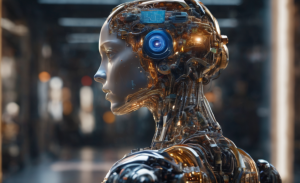Is AI more energy efficient and sustainable than humans?
4 min readTable of Contents
Imagine yourself as an artist. You could work on a masterpiece for days, putting all your energy and concentration into every brush stroke. But what if a computer could do something equally impressive in less than a minute?
This is not science fiction, but the power and reality of artificial intelligence (AI).
But who uses more energy and puts more strain on our planet? You with your brush and canvas or the computer?
Carbon footprints: humans vs. AI models
If you look at the actual costs of energy consumption, the numbers are clear.
First of all, the human brain, a marvel of energy efficiency that has a… Power of around 12 watts comes along.
In contrast, traditional computers with high-performance GPUs like the NVidia 3090 consume at computing-intensive tasks around 650 watts. That’s more than 50 times the energy consumption of the human brain in a single computer installation.
In the business world, however, there is even more at stake.
Let’s take an NVidia h100 in a data center, which alone around 700 watts of electricity is required. A supercomputer cluster created by an amazing 10,000 h100 GPUs can drive this energy demand to dizzying heights. That’s half a million times the power your brain uses.
These numbers are not only indicative of the rapidly growing energy demands of advanced computers, but also shine a glaring light on the sustainability problem underlying the AI revolution.
We are all faced with a crucial question: How to balance the meteoric rise of AI capabilities with the urgent need for environmental stewardship?
As we race toward a more digitalized future, we must confront the true costs of our technological energy hunger.
The dilemma of energy efficiency in AI and human activity
There’s an old saying: “You can’t improve what you can’t measure.”
However, comparing human carbon footprints with AI models is inherently flawed due to the complexity of defining boundaries in a rapidly evolving field that lacks transparency and accessible data.
Without detailed information about the hardware, power consumption, and energy sources, it is difficult to get an accurate estimate of AI’s carbon footprint.
Researcher of the University of California-Irvine and des WITH have published a study that has sparked a lively discussion among leading AI experts. The investigation poses preconceived ideas about energy consumptionof generative AI models such as ChatGPT in question.
The results show that the carbon dioxide equivalents (CO2e), which ChatGPT when creating a text page,130 to 1,500 times lower than those caused by a human doing the same activity.
It has also been found that AI models such as Mid-journey or DALL-E 2 from OpenAI produce 310 to 2,900 times less CO2e when creating images compared to humans.
The study concludes that AI technology shows promise in accomplishing a variety of tasks while producing significantly lower carbon emissions than humans.
Why AI and human capabilities are not easily comparable
The discussion about the energy and resource costs of AI compared to humans is anything but black and white.
It is an area with different scales and nuances. In some fields such as chess, AI systems have long been more powerful and energy efficient than humans.
However, this does not provide a comprehensive overview of AI’s capabilities across the full spectrum of human activities.
Imagine a task that an AI model was trained to do for a year and performed billions of times for different people, while a human might have trained for the same job for 30 years but only done it a dozen times .
AI may seem more efficient in this particular context, but it is important to remember that humans perform a variety of tasks that AI cannot. Not yet.
Comparing energy consumption in such cases is difficult not only because of the technical differences, but also because of ethical considerations.
People have lives beyond themselves “Tasks“. And this life uses resources that are not normally taken into account in a direct comparison.
Sustainability in the age of AI: More questions than answers
There are numerous technical and ethical problems when comparing artificial intelligence and human resource consumption.
Currently, AI can be used for specific tasks rather than the broad range of activities that make up human life. While AI may be more efficient in some cases, this is not necessarily a direct or fair comparison.
Ethically speaking, humans have a right to exist and consume resources for survival and well-being.
This is something that normally doesn’t happen “disabled“ just as a machine can be switched off.
Without entering ethically murky waters, we cannot adequately measure a person’s lifelong resource consumption using an AI model.
Conclusion
Sasha Luccioni, AI researcher and climate expert HuggingFacesaid:
“You can’t compare the carbon emissions of people and objects. People are more than just the work they do.“
The gaps in data availability severely limit our ability to comprehensively analyze environmental impacts. A transparent, science-based approach is needed to overcome this complexity.
It’s about much more than the question of who or what is more energy efficient. We should not take sides and consider the complex relationships that underlie our decisions.
Because if artificial intelligence is our future, then we should consciously choose it, knowing full well the costs – not just in watts or carbon dioxide emissions, but in the fabric of our human experience and shared responsibility for the planet we call home.
Crypto exchanges with the lowest fees 2023






